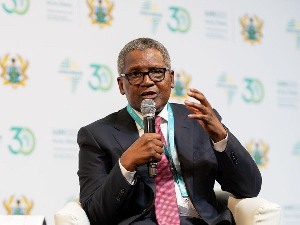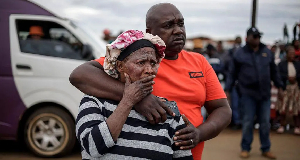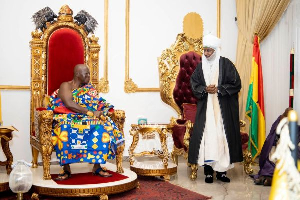Opinions of Friday, 9 April 2010
Columnist: Mangesi, Kofi
The Brong-Ashanti Divide (Part 2)
TANO-SUBIN: THE BRONG-ASHANTI DIVIDE (PART 2)
BY ABUBAKAR AKUMFI-AMEYAW (a.k.a KOFI MANHYIA)
The Colonial Government following the Indirect Rule helped the Asantehene to hold these villages and thus on 6th of February, 1948 Nana Akumfi Ameyaw III wrote to the secretary of the Ashanti Confederacy Council that he was unable to comply with the summons to attend the next meeting in Kumasi. The state elders, chiefs and sub- chiefs including three of the chiefs (Tanoso, Tuobodom and Offuman) from the nine villages forbade him to do so.
On the same day, another letter was sent to the Governor of the Gold Coast. It stated that the Takyiman State had broken off all communication with the Ashanti Confederacy and from now on would not pay the one third share to the Ashanti National Fund. Thus, in 1948 the Colonial Government by order No.115 of 1948 suspended Nana Akumfi Ameyaw III from acting as a Native Authority \and also by order No.5 of 1948 suspended the chiefs of the nine villages who have declared themselves openly for the Takyimanhene (Tanosohene, Tuobodomhene, and Chief of Offuman II) as members of the Tano-Subin Native Court. Apparently, the Takyiman secession was later supported by a number of Bono Chiefs. Nana Agyeman Badu and the Dormaa State Council, in December 1950, took offence at the decision of the Legislative Council Report on future Local Government in Asante. They claimed that they had little time to consider that Report before the Asanteman Council accepted it. The acceptance of the Report by Asanteman Council was something not done in the interest and welfare of the Dormaa people and a convenient pretext for Dormaa to secede from the Asante Confederacy.
Thus, supported by Bono Chiefs, on 10th of February 1951 Nana Akumfi Ameyaw III initiated the formation of Bono Kyempem Federation, with Takyiman, Dormaa, Abaase and Drobo as it nucleus members. In March, 1951, seven traditional areas in the North-Western and North-Eastern Asante inaugurated the Bono Political Movement known as the Bono-Kyempem Federation. In February 1956 the Bono Kyempem Council led by Nana Agyeman Badu was invited to the Achimota Conference to discuss the Report of the Constitutional Advisor. As time went on the Bono Kyempem Council was joined by secessionist Ahafo Chiefs spearheaded by the Kukuomhene.
In 1951 the Mate Kole Commission of enquiry into the Brong-Asante dispute was set up and it submitted its report in November 1952. It sympathized with the Bonos and below is a quotation from the report.
“The people (the Brongs) have been regarded and treated with every possible contempt by the Ashantis in the past. There is no gain saying that the so-called historic unity of Ashanti has all along been a unity maintained by a strong suppressing hand at the sacrifice of the freedom and happiness for the non-Ashanti people like the Brong.
I believe that our bid to remove imperialism from our country and to bring freedom and happiness to our people must not be limited only to the foreign forms of imperialism but also to local forms of imperialism. Freedom from fear within is as important to the happiness of men as freedom from fear without. To compel these people to continue to subject themselves to humiliation and exploitation from the Ashantis would be the saddest unkindness we would do to them. This is the reason why we have recommended that they should be given the council which they have asked for”.
A month later the Prime Minister, Dr. Kwame Nkrumah, visited Takyiman to re-open the Takyiman Native Courts which had been closed by the Colonial Government following the suspension of Nana Akumfi Ayemaw III.
In September, 1958, the ruling CPP Government passed the constitutional (Repeal of Restrictions) bill. Then on the 20th March, 1959, Mr. A.E.A Ofori Atta who was the Minister of Justice and Local Government introduced into the National Assembly under the certificate of urgency, the Brong Ahafo Regional Bill. The Bill came into effect on Saturday 4th April, 1959 when it appeared in Ghana Gazette No. 29. Thus the efforts of Brong Separatist Movement for independence from the Asanteman were crowned with success.
COUNCLUSION:
(i) From the foregoing one can understand that the Brong Ahafo region was not created for Administrative purposes but the Bono’s wanted to free themselves from Ashanti suppression, imperialism, humiliation and exploitation.
(ii) In 1818 Nana Mensah Bonsu confiscated the nine most prosperous villages from Takyiman because of their powerful gods and also to exploit them by way of selling their cocoa and other products (e.g. in October 1949 Ashanti Police was sent to confiscate the proceeds of the cocoa farm of the Tanosohene who had refused to go to Kumasi and with the Takyimanhene and it resulted in a heavy battle). The nine villages came back to Takyiman after the deportation of Nana Prempeh I and the signing of the treaty between Takyiman and the Queen of Britain in 1897. It was officially restored to Takyiman in 1900 by the Government. It was taken back by the committee of privileges with Asantehene and his chiefs as members of the committee and thus Takyiman seceding from the Ashanti Confederacy to initiate the formation of the Bono Kyempem Federation to fight for a separate region from Ashanti which was successful after the attainment of Independence in 1957 when all forms of slavery and imperialism ended and every Ghanaian became free. Thus the question of the Takyiman villages owing allegiance to the Asantahene should have ended after independence and the creation of the Brong Ahafo Region.
The constitution of this Committee of Privileges which transferred the Takyiman villages to Kumasi was very wrong. The Colonial Government made Asantehene a judge in his own case. Why was this undue privilege which was contrary to the British Justice and fair play not extended to Takyiman. If A and B have a dispute over a parcel of land then the Government would constitute a committee comprising A, the wife of A, the daughter of A and the son of A, to handle the case, my brother where on earth would you hear something like this? The villages therefore have not been for the Asantehene from ancient times as they have been saying. How can a King establish his Kingdom in an area in the 13th century and another establishing his about 80 miles away in the 17th century over 400 years after, and would have lands within 10 miles radius in the former’s kingdom. This is highly impossible. Let me quote a section of Nana Prempeh II’s speech at the last sitting of the committee of privileges on the claim by various Asante Chiefs on the villages from Techiman on the 25th November, 1935, when Takyimanhene angrily stated that he was going to litigate for his villages.
“Takyimanhene, I wish to advise you not to feel dissatisfied. Before Nana Opoku Ware wagged war against Takyiman, it was well known that Takyiman, was a very big state.
The people with whom you migrated to Jaman including the lands on which they live belong to you and you serve me with them; but the other villages together with their lands, which were taken from you, serve various chiefs to whom they were given. If you have retained the lands and the people who were taken from you, you would have been EQUAL to me, that is why after the war, they were taken from you and you became my Obirempong.”
Nananom, countrymen, the law does not support the claim that title to land has been based upon a right of conquest. In his celebrated book;
Casely Hayford, Gold Coast Native Institutions (1903) page 39.
“In all my several years of practice at the Bar I have not come across a case where title to land has been upon the right of conquest. The usage of war among aborigines would seem to be that, after the conclusion of peace the vanquished still retain their land.”
In the same book appear the following passages at page 53:
The right of the Asantehene over lands in the Kumasi Division was the same as the rights exercised by the Divisional Chiefs, in their own division. But over the lands of the Divisional Chiefs the Asantehene exercises no rights.
Nana Prempeh II at a meeting of the Confederacy Council in 1941 said a proposal of a measure to appoint a committee to hear appeals in land cases then under discussion:
“I would repeat that in introducing this measure I do not want to interfere with the right of any chief for any land” (from minutes of the confederacy Council, 1941).
Nananom, countrymen, this same Asantehene, (Prempeh II) together with several chiefs of the various Divisions of the Confederacy Council like Banda, Nkoranza, Jaman, Mo, Abaase, Dormaa, Berekum etc. signed on the 21st March, 1938, a Decision of Declaration of custom which clearly stated in paragraph one (1) that;
i) All land in the Ashanti is the property of the Stools of the various chiefs. Nananom, Countrymen this leads us to the celebrated Kaase case decided by the court of appeal. Kaase is a small town within the Kumasi Division which serves the Kumasi Paramount Stool. Kaase is one of the sub-stools around Kumasi which were conquered and subjugated by King Osei Tutu. The Ashantihene laid claim to the Kaase Stool land but lost. At the Appeal Court (1991) 2 GLR 416, the Court of Appeal held, affirming the judgment of the High Court that possessory title in Kaase Stool is vested in the Kaase Stool as against the Golden Stool.
Nananom, Countrymen, allegiance is not coterminus with ownership of land as can be seen in the book of Allegiance Versus Ownership of Land (Territory).
In The Truth About The West African Land Question, Casely Hayford defines allegiance at page 60 as;
Allegiance then is that personal relationship between the occupants of two stools whereby the inferior acknowledges the authority of the superior over him. Such acknowledgement may take the form of military or other services and occasionally an allegiance fee. Such relationship has nothing to do with the lands of the vassal. It may happen that the superior lord is at the same time the licensor of the vassal in respect of his holding but that will be merely accidental”.
Nananom, countrymen, from the foregoing why should we in the 21st century over 50 years after independence tolerate this confiscation of Takyiman villages by the Asantehene with the reason that if Takyiman is allowed to retain the villages it would be equal to him as was said by Nana Prempeh II (Minutes Committee of Privileges, 25th November, 1935).
This Tano- Subin issue should be condemned by any peace loving Ghanaian in this 21st century unless people want us to understand that armed robbery should be legalized so that people who envy others property can attack them and take them as theirs.
Let us look at the chronology of events of the recent clashes at Tuobodom one of the nine villages.
(a) The Omanhene of Takyiman, Oseadeyo Akumfi Ameyaw IV was attending the Yam Festival of Nana Obeng Ameyaw Barima the properly installed Tuobodomhene and the Akyeampemhene of the Techiman Traditional Area. The custodian of the Tuobodom Stool and the Tumpuduo Shrine, symbol of authority of any proper Akan Chief (It may interest you to know that all the chiefs of the Nine Villages with the exception of the Buoyemhene are Fetish Priests) controls the whole of Tuobodom Town. Krotia is a section of Tuobodom inhibited by various people from towns and villages in the Techiman Municipality. Those who say they pay allegiance to the Asanthene are a very few individuals leaving in about thirty houses within the Krotia section of Tuobodom.
(b) The so-called chief of Krotia who styles himself as the Paramount Chief of Tuobodom who had earlier written a letter to the Regional Security that there would be bloodbath when the Techimanhene passes through Krotia to attend the Yam Festival of Nana Obeng Ameyaw as Krotia is his land mounted a barrier at Krotia which is at the entry point of Tuobodom from Techiman in the broad daylight in the presence of heavy security guards. We are therefore not surprised if his boss says Techimanhene cannot pass through Kumasi to Accra.
(c) When the Techimanhene and his convoy got to the barrier and detected that this illegal barrier had been mounted in the presence of security personnel he advised his people to turn and go back to Techiman. In the process of turning the vehicles, bullets started flying from all corners denting cars and injuring people one of whom is now paralyzed and cannot talk. The people of Tuobodom who owe allegiance to the Techimanhene wanted to retaliate by crashing this handful of people at Krotia but, the Techiman Traditional Council advised them against any form of violence and reported the case to the police with the names of the suspects as the operation was during the day and the people saw people holding sophisticated weapons and firing. No arrest was made. The Regional Security and the IGP were petitioned and nothing happened. We are therefore not surprised to hear things like the Regional Police Commander and Regional Minister should be sacked. Also Tachimanhene says his party is in power. This implies someone used a political party and influential people to stop the arrest of the perpetrators of this heinous crime. They say the lawyer of the Krotia people who was then a Deputy Minister of State at the office of the President allegedly wrote to the police that they should not arrest them but he will bring them himself. Nananom, countrymen, what are we seeing in Ghana in this 21st century. Ya Naa was assassinated and no arrest was made, Mobila was killed and nothing happened. From the foregoing the Techimanhene would have been killed at that time and that would have been the end of it.
(d) We think the powers that influenced that these people should not be arrested are finding it difficult to do same now. The arrest of these people was declared and 4 were arrested at the Fiapre court in February and they were remanded in custody. On the 5th of March, 2010, two were spotted in Wenchi (the so-called Krotiahene and secretary) and were arrested and handed over to the police. Nananom, who would kidnap somebody and give him to the police?. If this so-called Paramount Chief who controls about twenty percent of the Tuobodom population (Nananom we should not disgrace the Institution of Chieftancy in Ghana) was tortured in Techimanhene’s palace as alleged he would not have been in that form to tell those lies to the Asantehene.
(e) After the so called Krotia Paramount Chief had been bailed by the lawyer, the lawyer went on radio stations misinforming people that the so called chief has been kidnapped and manhandled at the palace of the Techimanhene knowing the very reason why this man was arrested (assassination attempt on the Techimanhene). In the evening of that day 5/03/2010 the people of Krotia picked up arms and started shooting to kill people in Tuobodom. In the process a nephew of Nana Obeng Ameyaw who was walking in the street on the way to a brother’s house was shot. He was rushed to the hospital and later died in the night. The young men in Tuobodom could not restrain themselves under this circumstance, but had to descend on this Krotia people. As they are a handful of people they run away from the town when they were allegedly attacked.
Nananom, countrymen, judge for yourselves the justification of the arrest of Techimanhene and those who arrested this man and gave him to the police. This handful of people who have been armed to the teeth and given money to create confusion in the Techiman municipality just to champion the confiscation of Techiman villages by the Asantehene with the ancient belief that if Techimanhene being the King of the first centralized Akan State, when given those villages would be greater than the Asantehene. Lies which were properly rehearsed for presentation to win public sympathy were told and the Asantehene came out with all those things that you heard in the media.
We are not surprised because in the 18th century Nana Kwakye Ameyaw I gave gold in a pot to be sent to Nana Opoku Ware I who was a brother but it turned out that Baafo Pim took the gold and filled the pot with gunpowder which was presented to the Asantehene. Without any verification Asantehene mobilized forces and attacked Techiman. Today Koo Fante a self styled Paramount Chief who controls about twenty percent of the Tuobodom population told another lies and Takyimanhene would be kidnapped when he steps on Ashanti soil.
GOD BLESS GHANA












